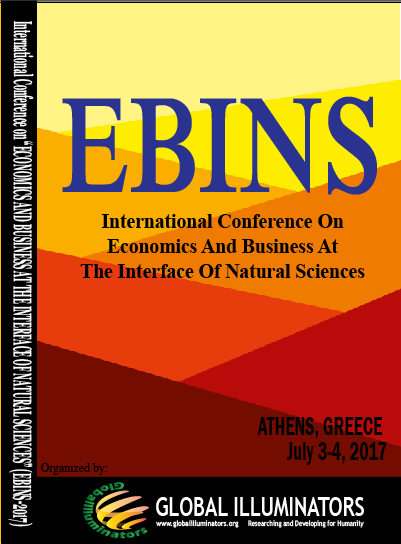
EBINS Proceedings
EBINS Proceeding
Volume 1, Pages 1-46
2017 EBINS Conference on “ECONOMICS AND BUSINESS AT THE INTERFACE OF NATURAL SCIENCES” (EBINS – 2017)
July 3-4, 2017 Athens Greece
Edited by Dr. Ahmed Saddam
pp. 1-46 (2017)
2017 EBINS Conference on “ECONOMICS AND BUSINESS AT THE INTERFACE OF NATURAL SCIENCES” (EBINS – 2017)
Track: Business Management and Economic Studies
The Relationships among Lean Production, Operational Performance, and Financial Performance
Pages 1-9
Piyachat Burawa
Abstract
The objective of this study is to investigate the relationships among lean production, operational performance, and firm performance; thereby, the study was conducted and accomplished by means of quantitative method using random sampling and snowball sampling. The results were analyzed by descriptive statistics, confirmatory factor analysis, and the structural equation modeling by using statistical software programs. Considering the quantitative approach, a survey was conducted with 629 current middle and top managers working in Thai manufacturing industry. The majority of respondents were male (56.3%) of the age above 40 years old (32.6%), factory/production manager (39.1%), bachelor’s degree (75.8%), working in medium size company (36.9%), nonautomotive (60.9%), and company age above 15 years (46.6%). The findings reported that there were positive relationships between lean production and operational performance, lean production and financial performance, and operational performance and financial performance. In addition, the results presented that there was partial effect of lean production on financial performance through operational performance. Considering the structural model level, the results further revealed that the model was not different across the automotive and nonautomotive industry, and the model was not different across the lean production adoption less than 5 years and above 5 years. Regarding the path level, the results reported that all of each path model level was not different across automotive and nonautomotive industry. Similarly, the lean production adoption, whether less than 5 years or above 5 years, did not have any effect on all of the path model levels.
The Impact of Environmental Regulation and Threats of Regulation on Environmental Performance for Canadian Firms: Expectations Versus Reality
Pages 10-21
Camélia Radu, Claude Francoeur
Abstract
regulation.
Track: Engineering and Technology Studies
Floor Radiant Heating System with PCM
Pages 22-29
Jin Chul Park, Sang Hoon Baek
Abstract
This study deals with the application of PCM to the floor heating system. The results of this study are summarized as follows: (1) The existing, in Korea, floor heating system has the problem that a large amount of hot water and energy are consumed because of the low thermal storage performance of light weight aerated concrete and mortar. To solve this problem, we proposed a design of the floor heating system with PCM by applying PCM as a thermal storage material. That is, the floor heating system with PCM is constructed by applying floor construction materials in the order of the 210 mm concrete slab, 20 mm buffer material, 15 mm mortar, 10 mm PCM aluminum case, 55 mm mortar, and the floor finish. (2) The applicable melting point of PCM for the floor heating was calculated using the heat transfer model equation proposed in this study, and when the 5 mm wood floor finish was applied, the melting points of PCM products available were calculated to range from 32 ℃ to 39 ℃.
An Interactive Real-Time Shadow Play System Using Kinect
Pages 30-33
Der-Lor Way
Abstract
This paper presents an interactive real-time shadow play system. We propose a novel digital and interactive real-time shadow play system using Microsoft Kinect. Users can operate the shadow characters by employing their body movement without any professional training. A performer’s skeleton data captured from Kinect is mapped into the shadow puppet’s component automatically. Additionally, users can create own digital shadow play animations. our system not only accomplishes human-computer interaction, but also promotes the digital archives of the intangible cultural heritage.
Track: Social Sciences and Humanities
Reconstruction of Social Science and Humanities through Narrative
Pages 34-41
Kang, Hyeon-Suk, Shin, Hye-Won
Abstract
The purpose of this paper is to present new directions and research strategies through critical analysis of the academic tendencies of existing social science and humanities. The narrative theory of human experience is adopted as a theoretical rationale for critical analyzing existing social sciences and humanities. Since the 1970s and 1980s, the academic tendencies of the humanities and social sciences have been transformed into narrative turn. However, the academic tendency of the humanities and social sciences is still divided into several subdisciplines, and as a result, there are problems of approaching the discipline from the individual and separate stance that cannot be integrated. These problems are linked to limitations in explaining the totality of human life in an integrated way, and academic researchers also have a tendency to separately approach disciplinary research activities. In order to improve these existing separated and divided attributes, we focus on the new integrity of humanities and social sciences in light of the narrative theory that approaches the totality of human life. The narrative theory for academic inquiry makes use of the position of Bruner, Polkinghorne, Ricoeur. To do this, we reviewed the literature related to the research topic and took an integrated approach to philosophical analysis of core claims. As a result, narrative theory has a characteristic approach to human life and experience as a whole, and it is possible to integrate by narrative ways of knowing. Based on this narrative theory, existing humanities and social sciences need to be reconstructed into narrative science. And narrative method or narrative inquiry is useful as its specific inquiry method. As a narrative science, humanities and social sciences can be implemented by the integration of human experience and narrative epistemology. It has the advantage of integrating the atomized sub-sciences into the narrative of human experience according to this new method. Also, in-depth research on concrete exploration strategies is expected in the future.
Bruner‟s Educational Theory and Its Implication: Focusing on New Humanities
Pages 42-46
Kang, Hyeon-Suk1*, Lee, Ji-Eun
